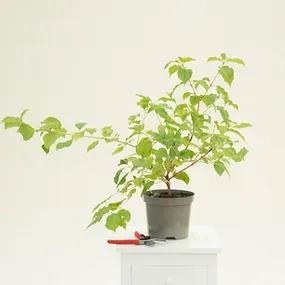'Midwinter Fire' Red Dogwood Plants

The details
Cornus sanguinea Midwinter Fire
Hedge Plants- Vibrant red & orange young stems.
- Ornamental shrub & hedging.
- Max. Height: 2m
- Bareroot Delivery Only: Nov-Mar
Recommended extras
Description
Cornus sanguinea Midwinter Fire: Bareroot Shrubs
Delivered by Mail Order Direct from our Nursery with a Year Guarantee
Cornus Midwinter Fire, is a medium sized, deciduous shrub with dense, upright growth and amazing red, yellow and orange winter bark - the closest thing to coral this side of the sea. The summer leaves are green, turning an excellent orange-yellow in the autumn, with small white flowers in May and June, which is all nice enough, although its real glory is in winter, when it will light your garden up on the dismal days between November and March. It will reach 2 metres.
View our selection of dogwood shrubs or see our full range of hedging.
Delivery season: Dogwood plants are delivered bareroot during late autumn and winter, approximately November-March inclusive.
Features
- Stunning bark in winter.
- Height: To 2m
- Soil: Loves wet sites.
- Use: Specimen shrub, ornamental hedging.
- Cut back hard yearly to get the best display.
- RHS Recommendation for bees & other pollinators
Growing Cornus Midwinter Fire
Like all dogwoods, it loves damp ground, but once it is established it will grow happily on a dry bank. It will grow faster in the sun, but partial shade is fine.
To keep those beautiful new stems coming, coppice them by cutting them down to the base every Spring: cut above the third bud up from soil level on new plants. Mature plants will develop a stool, and you can use your own judgement about how much you remove, depending on how you like to manage your plants. Give them a nice mulch afterwards to help them bounce back vigorously.
Midwinter Fire Dogwood in your Garden
We think Midwinter Fire Dogwood is at its best in a massed planting, with or without other dogwoods to set it off like the purple Kesselringii or the red Westonbirt. It is not as vigorous as the other dogwoods, so plant it at the front if you are using it in a mixed patch.
It goes well with pretty much any evergreen as a backdrop, and because you chop it down yearly, all sorts of spring flowering bulbs can be deployed to provide interest while it regrows.
It is an interesting choice for an ornamental hedge that has no security or privacy purpose, because it needs to be cut close to the ground yearly (if you want that winter bark). For this purpose, a 50-75cm spacing is fine, because you aren't trying to make it into a proper barrier. For a real hedge, we would use common dogwood instead.
Planting Instructions
Growing Cornus sanguinea Midwinter Fire plants:
It will grow well in any soil, and needs at least half a day of full sun. It loves wet ground, but will tolerate dry soils once established.
Prepare your site before planting:
The only essential preparation is to kill the weeds. Improving the soil by digging in some well rotted manure and/or compost is worthwhile as you will get more growth with colourful bark for the winter. Remember to water establishing plants during dry weather for at least a year after planting. Watering should be thorough, so the ground is soaked. Let the soil almost dry out before watering again. Watering & weeding will be necessary for at least a year after planting.
You will also need to weed around the plants.
Trimming Dogwood: To get the best bark colour each winter, all you need to do is to coppice (hard prune) your plants, starting in their first year after planting.
In March, use clean secateurs to cut all the stems down to about 15cm, 6 inches, from ground level, varying the height of the cuts if you don't want the shape to become too uniform. After that, apply a good blanket of mulch around, without touching, the plants.
Hygiene & Diseases:
Dead, damaged or diseased wood can be pruned off as soon as it appears.
Did You Know?
This variety was discovered by chance in a German garden by H. Venhorst in the early 1980's, and it was released for sale in 1990.

 3.webp)
 3.webp)
 1.webp)

 4.webp)
 5.webp)
 2.webp)